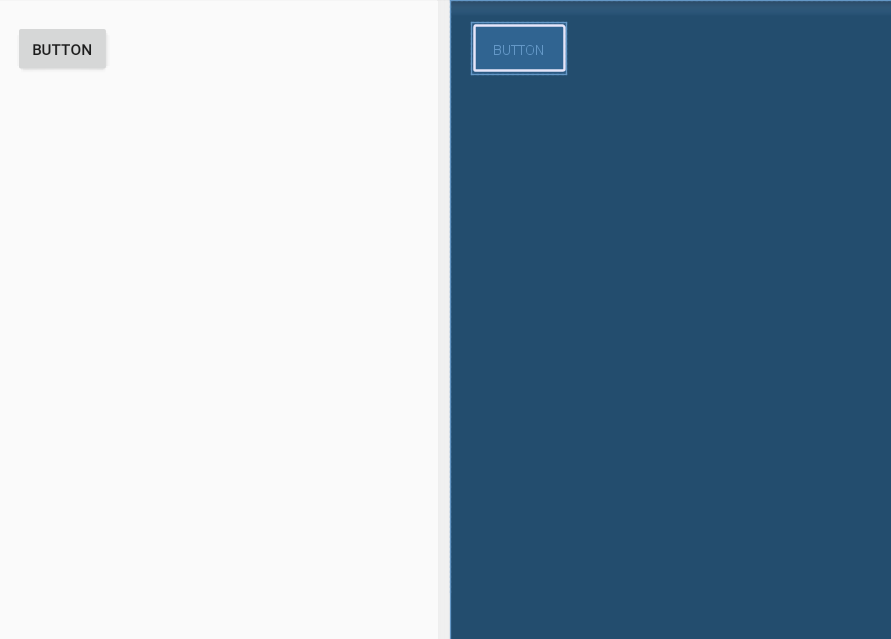為了能利用應用程式與使用者互動,Android Studio提供許多元件方便開發者利用,而現在就開始進入使用者互動的開發吧~Let’s go!
一開始我們來學學大家最常使用到的元件--按鈕(Button)。按鈕在app上是非常普遍的開發元件,他可以提供使用者觸發後執行一連串開發者所設計的流程。
提供使用者少用按鈕必須要實作偵聽器,偵聽使用者是否有作觸發動作以便程式做下一步動作,觸發後,還要實作觸發的內容以便回應使用者。下方要實作UI設計與Java程式設計。
開發者可以由左方的Palette中選取Button拖拉至設計版面上。如下圖:
其XML檔為
<?xml version="1.0" encoding="utf-8"?>
<LinearLayout xmlns:android="http://schemas.android.com/apk/res/android"
xmlns:app="http://schemas.android.com/apk/res-auto"
xmlns:tools="http://schemas.android.com/tools"
android:layout_width="match_parent"
android:layout_height="match_parent"
android:orientation="vertical"
tools:context=".MainActivity">
<!--Button-->
<!--設定元件的識別編號-->
<!--元件在版面的寬度為元件內容大小-->
<!--元件在版面的高度為元件內容大小-->
<!--距離間隔版面20sp-->
<!--按鈕文字為Button-->
<Button
android:id="@+id/btn"
android:layout_width="wrap_content"
android:layout_height="wrap_content"
android:layout_margin="20sp"
android:text="Button"
android:layout_marginTop="5dp"
/>
</LinearLayout>
這樣就輕鬆完成一個按鈕了~好開心 >W<![]()
接者來看Java程式設計吧!
倘若一個按鈕需要有功能,必須要實作偵聽器及觸發內容。下面分享三種實作方法給大家參考:
建立偵聽器需要建立Button.OnClickListener物件
public class MainActivity extends AppCompatActivity {
private Button btn;
@Override
protected void onCreate(Bundle savedInstanceState) {
super.onCreate(savedInstanceState);
setContentView(R.layout.activity_main);
findViews();
setListener();
}
private void setListener() {
// 設定偵聽器(指定偵聽物件)
btn.setOnClickListener(listener);
}
private void findViews() {
// 找到按鈕元件的id
btn = (Button)findViewById(R.id.btn);
}
//實作偵聽器
Button.OnClickListener listener= new Button.OnClickListener() {
// 實現按鈕觸發後行為
@Override
public void onClick(View v) {
// 設定Button元件顯示文字
btn.setText("觸發成功");
// 設定Button元件背景顏色
btn.setBackgroundColor(Color.rgb(0,255,0));
}
};
}
匿名類別建立偵聽器
public class MainActivity extends AppCompatActivity {
private Button btn;
@Override
protected void onCreate(Bundle savedInstanceState) {
super.onCreate(savedInstanceState);
setContentView(R.layout.activity_main);
findViews();
setListener();
}
private void setListener() {
// 匿名類別建立偵聽器並實作觸發方法
btn.setOnClickListener(new View.OnClickListener() {
@Override
public void onClick(View view) {
// 設定Button元件顯示文字
btn.setText("觸發成功");
// 設定Button元件背景顏色
btn.setBackgroundColor(Color.rgb(0,255,0));
}
});
}
private void findViews() {
// 找到按鈕元件的id
btn = (Button)findViewById(R.id.btn);
}
}
到XML檔加入android:onClick
<!--設定偵聽器android:onClick="listener"-->
<Button
android:id="@+id/btn"
android:layout_width="wrap_content"
android:layout_height="wrap_content"
android:layout_margin="20sp"
android:onClick="listener"
android:text="Button"
android:layout_marginTop="5dp"
/>
到Java檔內,建立觸發方法
public class MainActivity extends AppCompatActivity {
private Button btn;
@Override
protected void onCreate(Bundle savedInstanceState) {
super.onCreate(savedInstanceState);
setContentView(R.layout.activity_main);
findViews();
setListener();
}
private void findViews() {
// 找到按鈕元件的id
btn = (Button)findViewById(R.id.btn);
}
public void listener(View view) {
// 設定Button元件顯示文字
btn.setText("觸發成功");
// 設定Button元件背景顏色
btn.setBackgroundColor(Color.rgb(0,255,0));
}
}
恭喜大家完成按鈕實作
最後,希望大家能分享自己的專屬按鈕。
下篇文章見囉!
Thank you for your time.
